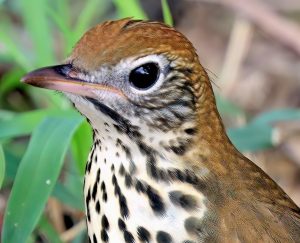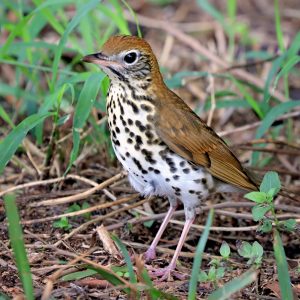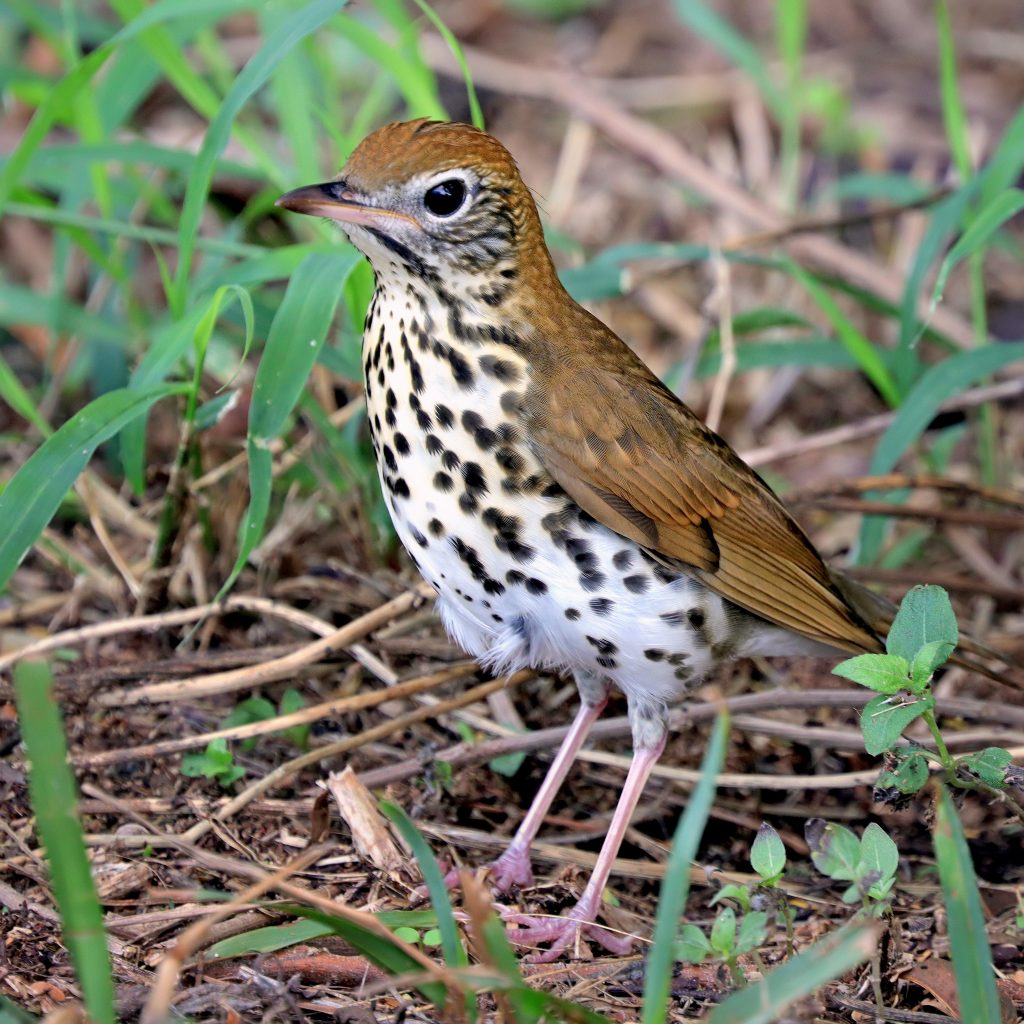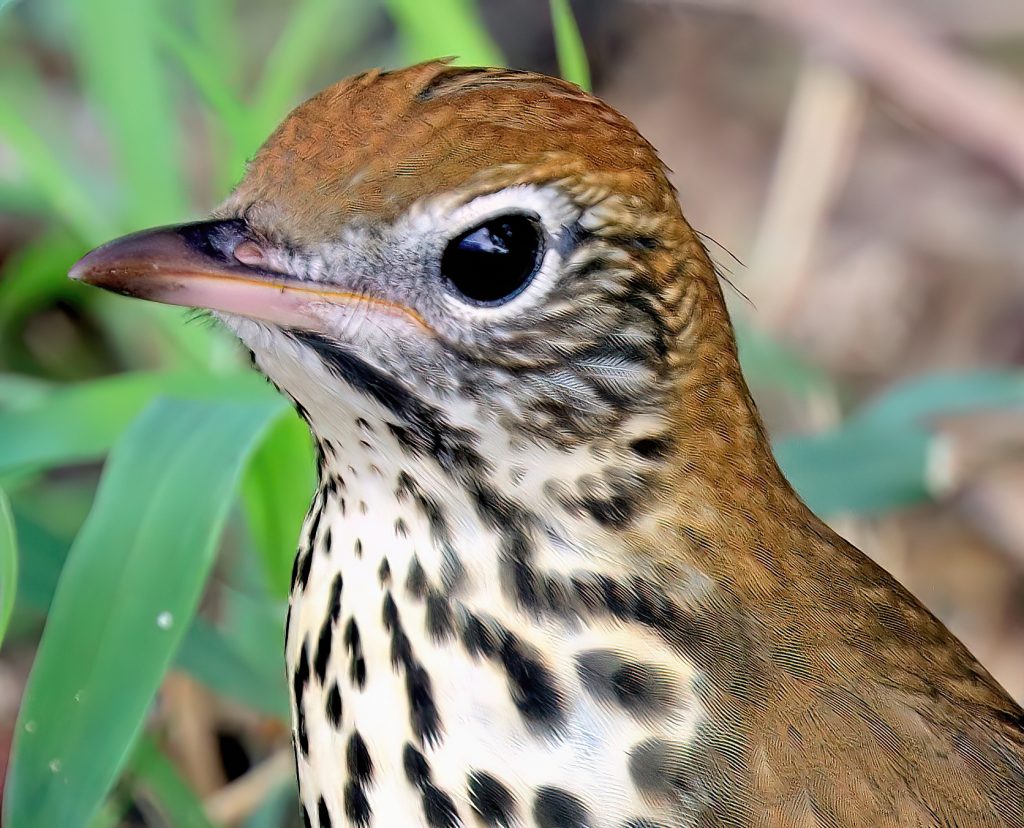This wide-eyed thrush—pot-belled, brown-spotted and robin-like in posture—traipsed among eager photographers at the South Padre Island Convention Center one October. It, like other migrants resting and refueling during their southward journey, looked weary..

The Rio Grande Valley, like a busy airport, sponsors a perpetual rainbow of avian traffic. Migrants like the wood thrush stop off during northern and southern trips. Others, like white pelicans, avocets and various raptors, winter here, relishing our ample food supplies. Groove-billed anis breed here each summer, and post-breeding wood storks feed in our well-supplied mudflats and salt marshes. Plus, numerous species, including vivid green jays and great kiskadees, thrive here year-round.
The rusty head, chestnut back and mottled underparts of the wood thrush (Hylocichla mustelina) help it blend in with the thick understory it prefers. The thrush’s huge, white-ringed eyes enhance its vision in shady woods, especially at dusk and early dawn, when it is often the first to burst into song. Its upright posture, shared with its fellow thrush, the American robin, readily distinguishes it from the similarly colored brown thrasher.
The wood thrush breeds in damp, mixed-wood forests, along streams and in woody swamps in eastern North America, from southern Canada to the Gulf, including East Texas, westwards towards Dallas and Houston. Nighttime travelers, thrushes leave their Texas homes in mid-September to mid-November for wintering grounds in Mexico or Central America. Loyal to both breeding and wintering areas, wood thrushes spend their lifetimes flying thousands of miles from one patch to the other. Prior to their autumn trek, thrushes often travel some ways from their nesting grounds to molt. Their spring and fall routes differ, with the former veering farther west.

An omnivorous creature, the wood thrush hops on the ground, pauses, then, with its long, thin mandible, probes the ground for insects and assorted invertebrates, tossing leaves aside. It eats snails, an excellent source of calcium. It may also hunt from low branches and glean prey from leaves, hover or catch insects in flight. Also, this thrush eats fruits and berries, which constitute about a third of its diet.
Wood thrushes create pair-bonds, but often engage in extra copulation. The male arrives first, snapping up territory, with the female arriving a few days later. In courtship, she may, lifting wings and fluffing feathers, coax the male into a fast, circular flight, after which the pair shares a meal. She constructs an open cup nest of mud, leaves, grass and rootlets, into which she lays three or four bluish green eggs. She, unlike most thrushes, may also add paper, cloth and other colorful trash, perhaps—in breaking up the nest’s familiar contours—to disguise it from predators. She incubates eggs, but both thrushes feed chicks and ardently defend the nest, with the male keeping watch, sometimes singing from the nest’s rim.
Eggs hatch in about two weeks, and birds attempt two broods, sometimes three, a year. Many creatures—including blue jays, squirrels and raccoons—prey upon eggs and nestlings. Cowbirds—fending off pecking, biting thrushes—often manage to deposit eggs in their nests, fooling parents into raising the larger, early-hatching cowbird chicks, at the expense of their own.
Many thrill to the wood thrush’s song—especially a male’s clear, flute-like three-part tune, an ee-o-lay, ending with a trill, its liquid notes interspersed with pauses and gutturals. Famed naturalist and author Henry David Thoreau wrote, “This is the only bird whose note affects me like music, affects the flow and tenor of my thought, my fancy and imagination. It lifts and exhilarates me.”
Rather than a larynx, most birds produce sound via a y-shaped syrinx—a two-part organ with tiny sets of independent muscles which power airflow through its sides. The wood thrush, unlike many birds—whose syrinxes produce different ranges of tones—creates songs in the same range through both sides. It harmonizes beautifully with itself.
Partners in Flight have placed the wood thrush on its Yellow Watch as a bird with declining numbers, populations having dropped 59% between 1970 and 2014. As with other birds, insecticide, collisions and habitat degradation cause deaths, with crashes more common, interestingly, during fall migration. It appears that wood thrushes adapt well to some fragmentation of woodlands, perhaps since their territories are small, but this also makes them more vulnerable to cowbird predation. Many thrushes, thankfully, spend winters on shade-grown coffee farms, which preserve native trees.

